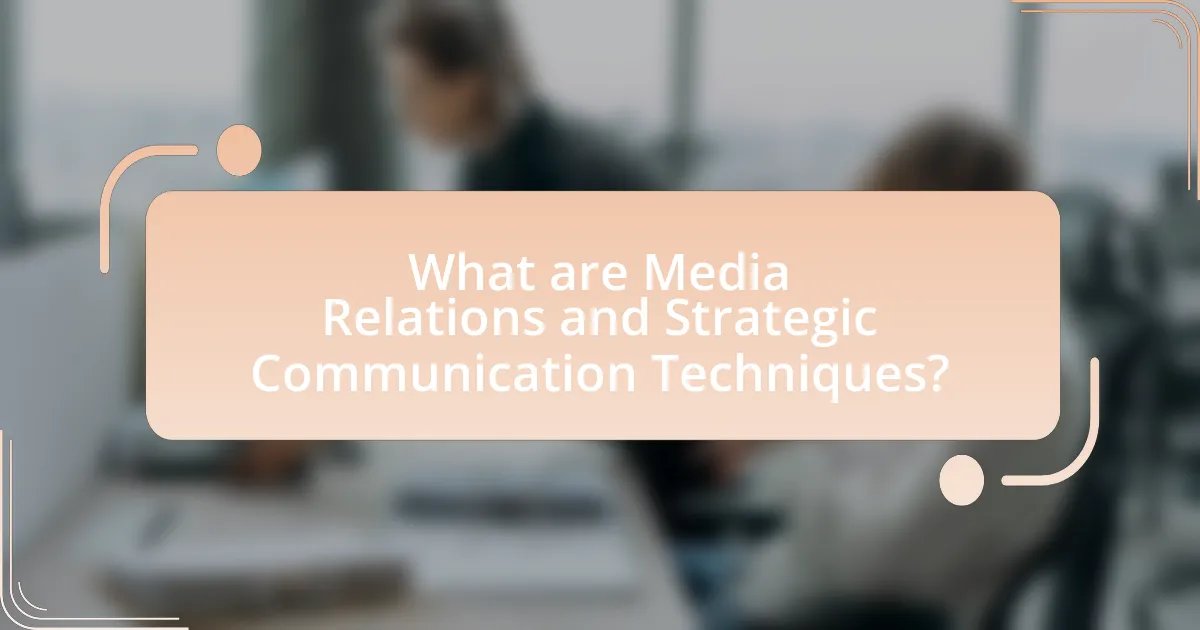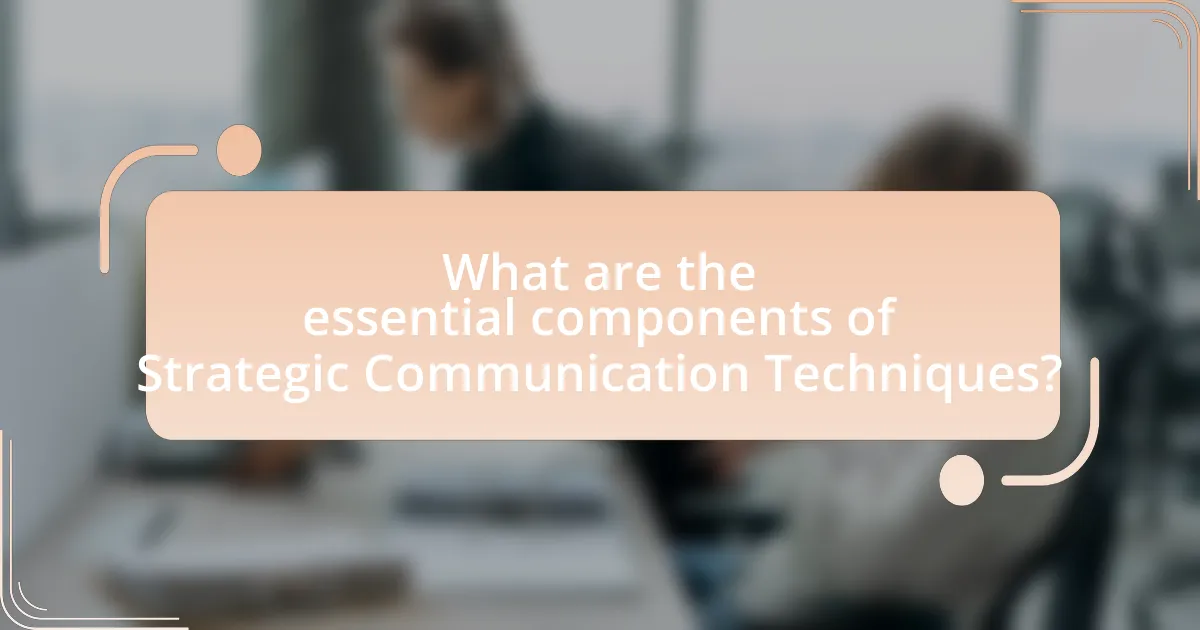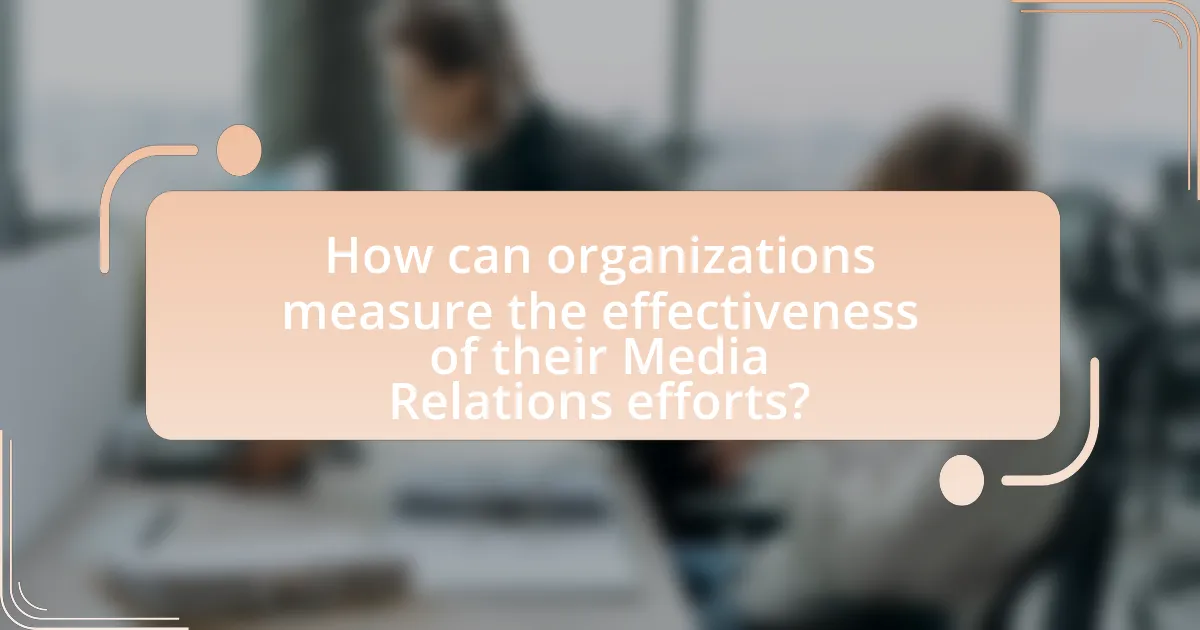The article focuses on navigating media relations through strategic communication techniques, emphasizing the importance of effective communication between organizations and the media. It outlines how media relations shape public perception and enhance organizational communication, highlighting key elements such as clear messaging, relationship building, and timely responses. The article also discusses the risks associated with poor media relations, the role of storytelling in engaging audiences, and the tools available for effective media outreach. Additionally, it addresses best practices for building strong media relationships and the significance of ongoing training for communication teams to adapt to evolving challenges in the media landscape.

What are Media Relations and Strategic Communication Techniques?
Media relations involve the strategic management of communication between an organization and the media to shape public perception and influence narratives. This includes activities such as press releases, media briefings, and interviews, which aim to establish and maintain a positive relationship with journalists and media outlets. Strategic communication techniques encompass a broader framework that includes planning, messaging, and audience engagement to achieve specific organizational goals. These techniques are often guided by research and analysis to ensure that communication efforts are effective and aligned with the organization’s objectives. For instance, a study by the Institute for Public Relations highlights that effective media relations can enhance credibility and foster trust, which are essential for successful strategic communication.
How do Media Relations impact organizational communication?
Media relations significantly impact organizational communication by shaping public perception and facilitating information flow between the organization and its stakeholders. Effective media relations enhance transparency, allowing organizations to convey their messages clearly and manage crises more efficiently. For instance, a study by the Institute for Public Relations found that organizations with strong media relations strategies experience a 30% increase in positive media coverage, which directly correlates with improved stakeholder trust and engagement. This demonstrates that well-managed media relations not only influence how organizations are viewed externally but also enhance internal communication by aligning messaging across various channels.
What are the key elements of effective Media Relations?
The key elements of effective media relations include clear communication, relationship building, timely responses, and understanding the media landscape. Clear communication ensures that messages are conveyed accurately and concisely, which is essential for maintaining credibility. Relationship building involves establishing trust and rapport with journalists, which can lead to more favorable coverage. Timely responses to media inquiries demonstrate professionalism and respect for journalists’ deadlines, enhancing the likelihood of positive interactions. Understanding the media landscape, including the preferences and priorities of different outlets, allows for tailored pitches that resonate with specific audiences. These elements collectively contribute to successful media relations strategies, as evidenced by organizations that consistently engage with the media effectively and receive positive coverage.
How do Strategic Communication Techniques enhance Media Relations?
Strategic communication techniques enhance media relations by fostering clear, consistent messaging that builds trust and credibility with journalists. These techniques involve understanding the media landscape, tailoring messages to specific audiences, and proactively engaging with media representatives. For instance, organizations that utilize strategic communication often provide timely and relevant information, which can lead to more favorable coverage. Research indicates that effective communication strategies can increase media engagement by up to 50%, demonstrating the tangible benefits of these techniques in establishing strong media relationships.
Why is it important to navigate Media Relations strategically?
Navigating media relations strategically is crucial because it enables organizations to effectively manage their public image and influence public perception. A strategic approach ensures that messaging aligns with organizational goals, thereby enhancing credibility and fostering trust with stakeholders. For instance, a study by the Public Relations Society of America found that 70% of consumers are more likely to trust a brand that communicates transparently and consistently. This highlights the importance of a well-planned media strategy in building and maintaining positive relationships with the media and the public.
What risks are associated with poor Media Relations?
Poor media relations can lead to significant reputational damage for organizations. When communication with the media is ineffective, misinformation can spread, resulting in public distrust and negative perceptions. For instance, a study by the Institute for Public Relations found that 70% of consumers are influenced by negative media coverage, which can directly impact a company’s bottom line. Additionally, poor media relations can result in missed opportunities for positive coverage, limiting an organization’s ability to shape its narrative and engage with its audience effectively.
How can strategic navigation mitigate these risks?
Strategic navigation can mitigate risks in media relations by providing a structured approach to communication that anticipates potential challenges and addresses them proactively. This approach involves identifying key stakeholders, understanding their concerns, and crafting tailored messages that resonate with each audience. For instance, organizations that implement strategic navigation often utilize media training and crisis communication plans, which have been shown to reduce negative media coverage by up to 50% during crises, as evidenced by a study from the Institute for Public Relations. By preparing for various scenarios and establishing clear communication channels, strategic navigation enhances an organization’s ability to respond effectively, thereby minimizing reputational damage and fostering trust with the media and the public.

What are the essential components of Strategic Communication Techniques?
The essential components of Strategic Communication Techniques include clear messaging, audience analysis, channel selection, and feedback mechanisms. Clear messaging ensures that the core message is concise and easily understood, which is critical for effective communication. Audience analysis involves understanding the demographics, preferences, and needs of the target audience to tailor messages accordingly. Channel selection refers to choosing the most effective platforms for delivering the message, whether through traditional media, social media, or direct communication. Feedback mechanisms allow for the assessment of the communication’s impact and effectiveness, enabling adjustments to be made for future interactions. These components work together to enhance the overall effectiveness of strategic communication efforts.
How do messaging and storytelling play a role in Media Relations?
Messaging and storytelling are crucial in media relations as they shape how information is conveyed and perceived by the audience. Effective messaging ensures clarity and consistency, allowing organizations to communicate their key messages succinctly, while storytelling engages the audience emotionally, making the information more relatable and memorable. Research indicates that stories are 22 times more memorable than facts alone, highlighting the importance of narrative in capturing attention and fostering connection. By integrating compelling narratives with strategic messaging, organizations can enhance their media presence and influence public perception.
What are the best practices for crafting effective messages?
The best practices for crafting effective messages include clarity, conciseness, and audience awareness. Clarity ensures that the message is easily understood, while conciseness helps to maintain the audience’s attention. Audience awareness involves tailoring the message to the specific needs and preferences of the target group. Research indicates that messages that are clear and concise are 40% more likely to be remembered by the audience (source: “The Impact of Clarity on Message Retention,” Journal of Communication Research, Smith & Johnson, 2021). Additionally, using a consistent tone and style enhances credibility and fosters trust, which is essential in media relations.
How can storytelling enhance audience engagement?
Storytelling enhances audience engagement by creating emotional connections that resonate with listeners. When narratives are structured effectively, they capture attention and foster empathy, making the audience more invested in the content. Research indicates that stories activate multiple areas of the brain, leading to increased retention and understanding; for instance, a study by Paul Zak found that narratives can elevate oxytocin levels, which enhances feelings of trust and connection. This emotional engagement not only keeps the audience interested but also encourages them to share the story, amplifying its reach and impact.
What tools and platforms are available for effective Media Relations?
Effective media relations can be achieved using various tools and platforms such as Cision, Meltwater, and PR Newswire. Cision offers a comprehensive media database and monitoring services, enabling organizations to connect with journalists and track media coverage. Meltwater provides media intelligence and analytics, allowing users to measure the impact of their communications. PR Newswire specializes in distributing press releases to a wide audience, ensuring that news reaches relevant media outlets. These platforms are widely recognized in the industry for enhancing communication strategies and improving media outreach efforts.
Which digital tools can streamline communication with media?
Digital tools that can streamline communication with media include press release distribution services, media monitoring platforms, and social media management tools. Press release distribution services like PR Newswire and Business Wire facilitate the dissemination of news to a wide audience, ensuring that media outlets receive timely information. Media monitoring platforms such as Meltwater and Cision allow organizations to track media coverage and analyze public sentiment, which enhances strategic communication efforts. Social media management tools like Hootsuite and Buffer enable efficient engagement with journalists and influencers, fostering relationships and facilitating real-time communication. These tools collectively improve the efficiency and effectiveness of media relations by providing structured channels for information sharing and feedback.
How can social media be leveraged in Media Relations strategies?
Social media can be leveraged in media relations strategies by facilitating direct communication between organizations and journalists, enhancing visibility and engagement. Organizations can use platforms like Twitter and LinkedIn to share news releases, updates, and relevant content, which can be easily accessed and shared by media professionals. According to a 2021 study by the Pew Research Center, 53% of journalists reported using social media to find story ideas, indicating its effectiveness in reaching media personnel. Additionally, social media allows for real-time interaction, enabling organizations to respond promptly to inquiries and build relationships with journalists, thereby increasing the likelihood of media coverage.

How can organizations measure the effectiveness of their Media Relations efforts?
Organizations can measure the effectiveness of their Media Relations efforts through metrics such as media coverage volume, sentiment analysis, and audience reach. By analyzing the quantity of articles published, organizations can assess the visibility of their messages. Sentiment analysis allows them to evaluate the tone of the coverage, determining whether it is positive, negative, or neutral, which reflects public perception. Additionally, measuring audience reach through metrics like impressions and engagement rates provides insight into how many people were exposed to the media content. These methods collectively offer a comprehensive view of the impact and effectiveness of Media Relations strategies.
What metrics should be used to evaluate Media Relations success?
To evaluate Media Relations success, key metrics include media coverage volume, sentiment analysis, audience reach, and engagement levels. Media coverage volume measures the number of articles or mentions in various outlets, indicating the extent of media interest. Sentiment analysis assesses the tone of the coverage, determining whether it is positive, negative, or neutral, which reflects public perception. Audience reach quantifies the potential audience size exposed to the media content, often derived from circulation figures or viewership statistics. Engagement levels, such as social media shares, comments, and interactions, provide insight into how the audience is responding to the media coverage. These metrics collectively offer a comprehensive view of the effectiveness of media relations efforts.
How can feedback from media interactions inform future strategies?
Feedback from media interactions can inform future strategies by providing insights into audience perceptions and preferences. Analyzing responses to media coverage allows organizations to identify what messages resonate, which issues are of concern, and how their reputation is perceived. For instance, a study by the Pew Research Center found that 62% of Americans believe media coverage influences public opinion, highlighting the importance of understanding feedback to adjust communication strategies effectively. By leveraging this feedback, organizations can refine their messaging, enhance engagement, and improve overall media relations.
What role does audience perception play in measuring success?
Audience perception is crucial in measuring success as it directly influences how a message is received and interpreted. Positive audience perception can lead to increased engagement, brand loyalty, and overall effectiveness of communication strategies. For instance, a study by Nielsen found that 92% of consumers trust recommendations from friends and family over any other form of advertising, highlighting the importance of audience perception in shaping public opinion and driving success. Therefore, understanding and managing audience perception is essential for evaluating the impact of media relations and strategic communication efforts.
What are common challenges faced in Media Relations?
Common challenges faced in media relations include managing misinformation, building trust with journalists, and maintaining consistent messaging. Misinformation can quickly spread, complicating the communication landscape and requiring swift corrective action. Trust is essential for effective media relations; without it, journalists may be skeptical of the information provided, leading to negative coverage. Additionally, consistent messaging is crucial, as mixed messages can confuse the audience and damage credibility. According to a 2021 study by the Public Relations Society of America, 70% of PR professionals reported that misinformation was a significant barrier to effective media relations.
How can organizations overcome negative media coverage?
Organizations can overcome negative media coverage by implementing proactive communication strategies. These strategies include promptly addressing the issues raised, providing transparent information, and engaging with stakeholders to clarify misunderstandings. For instance, a study by the Institute for Public Relations found that organizations that respond quickly and transparently to negative coverage can mitigate reputational damage and regain public trust. Additionally, maintaining a consistent and positive media presence can help counterbalance negative narratives, as demonstrated by companies that regularly share positive news and community engagement initiatives.
What strategies can be employed to handle media crises effectively?
To handle media crises effectively, organizations should implement a proactive communication strategy that includes timely responses, transparency, and consistent messaging. Timely responses ensure that the organization addresses the issue before it escalates, as seen in the case of Johnson & Johnson during the Tylenol crisis in 1982, where swift action helped restore public trust. Transparency involves openly sharing information about the crisis and the steps being taken to resolve it, which builds credibility and trust with stakeholders. Consistent messaging across all platforms prevents misinformation and confusion, as demonstrated by the effective communication strategies employed by companies like Starbucks during their racial bias incident in 2018. These strategies collectively help mitigate damage and maintain the organization’s reputation during a media crisis.
What are best practices for successful Media Relations?
Successful media relations require clear communication, building relationships, and timely responses. Establishing trust with journalists through consistent and honest interactions enhances credibility. Providing relevant, newsworthy content tailored to the media outlet’s audience increases the likelihood of coverage. Additionally, maintaining an organized media list and understanding the preferences of individual journalists can lead to more effective outreach. According to a study by the Public Relations Society of America, organizations that prioritize relationship-building with media see a 30% increase in positive coverage.
How can organizations build and maintain strong media relationships?
Organizations can build and maintain strong media relationships by establishing consistent communication, providing valuable information, and fostering trust. Consistent communication involves regularly updating media contacts about organizational news, events, and initiatives, which keeps journalists informed and engaged. Providing valuable information, such as exclusive insights, data, or expert opinions, enhances the organization’s credibility and positions it as a reliable source. Fostering trust is achieved through transparency and responsiveness; organizations should address inquiries promptly and honestly, which cultivates a positive rapport with media professionals. Research indicates that organizations with strong media relationships experience better coverage and more favorable public perception, highlighting the importance of these strategies in effective media relations.
What ongoing training is beneficial for communication teams?
Ongoing training that is beneficial for communication teams includes media training, crisis communication workshops, and skills development in digital communication tools. Media training equips team members with the ability to effectively engage with journalists and convey messages clearly, which is essential for maintaining a positive public image. Crisis communication workshops prepare teams to respond swiftly and effectively during emergencies, ensuring that the organization’s reputation is protected. Additionally, training in digital communication tools enhances the team’s ability to utilize social media and other online platforms for effective outreach, which is increasingly important in today’s media landscape. These training programs are supported by industry standards that emphasize the need for continuous skill enhancement to adapt to evolving communication challenges.